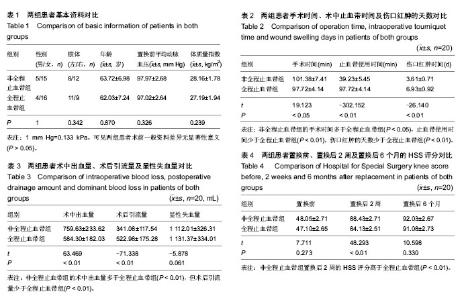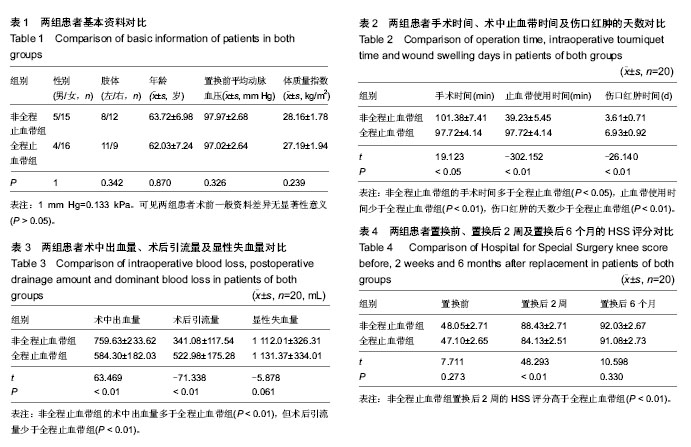| [1] Tahmasebi MN, Bashti K, Ghorbani G, et al. Intraarticular Administration of Tranexamic Acid Following Total Knee Arthroplasty: A Case-control Study. Arch Bone Jt Surg. 2014; 2(3):141-145.
[2] Feng B, Weng X, Lin J,et al. Long term follow up of clinical outcome between patellar resurfacing and nonresurfacing in total knee arthroplasty: Chinese experience. Chin Med J (Engl). 2014;127(22):3845-3851.
[3] Liu J, Li XF, Xu KL, et al.Bilateral Total Knee Arthroplasty for Charcot Knees Associated with Tabes Dorsalis. Pain Physician. 2014;17(6):E796-799.
[4] Marya SK, Thukral R. Outcome of unicompartmental knee arthroplasty in octogenarians with tricompartmental osteoarthritis: A longer followup of previously published report. Indian J Orthop. 2013;47(5):459-468.
[5] Tarwala R, Dorr LD, Gilbert PK, et al. Tourniquet use during cementation only during total knee arthroplasty: a randomized trial. Clin Orthop Relat Res. 2014;472(1):169-174.
[6] Olivecrona C, Ponzer S, Hamberg P, et al. Lower tourniquet cuff pressure reduces postoperative wound complications after total knee arthroplasty: a randomized controlled study of 164 patients. J Bone Joint Surg Am. 2012;94(24):2216-2221.
[7] Dutton T, De-Souza R, Parsons N, et al. The timing of tourniquet release and 'retransfusion' drains in total knee arthroplasty: A stratified randomized pilot investigation. Knee. 2012;19(3):190-192.
[8] 沈忠伟,童培建,邵营钢,等.止血带对全膝关节置换术后肿胀及功能影响的临床研究[J].浙江临床医学,2010,12(3):261-262.
[9] Lee KJ, Moon JY, Song EK, et al. Minimum Two-year Results of Revision Total Knee Arthroplasty Following Infectious or Non-infectious Causes.Knee Surg Relat Res. 2012;24(4): 227-234.
[10] Causero A, Di Benedetto P, Beltrame A, et al. Design evolution in total knee replacement: which is the future? Acta Biomed. 2014;85(2):5-19.
[11] Haidukewych GJ, Petrie JR, Adigweme O. The multiply- operated total knee replacement patient: salvage options. Bone Joint J. 2014;6-B(11 Supple A):122-124.
[12] Kvederas G, Porvaneckas N, Andrijauskas A, et al. randomized double-blind clinical trial of tourniquet application strategies for total knee arthroplasty. Knee Surg Sports Traumatol Arthrosc. 2013;21(12):2790-9.
[13] Huang ZY, Pei FX, Ma J, et al. Comparison of three different tourniquet application strategies for minimally invasive total knee arthroplasty: a prospective non-randomized clinical trial. Arch Orthop Trauma Surg. 2014;134(4):561-570.
[14] Ishii Y, Noguchi H, Matsuda Y, et al. A new tourniquet system that determines pressures in synchrony with systolic blood pressure in total knee arthroplasty. J Arthroplasty. 2008;23(7): 1050-1056.
[15] Tomita M, Motokawa S. Effects of air tourniquet on the antibiotics concentration, in bone marrow, injected just before the start of operation. Mod Rheumatol. 2007;17(5):409-412.
[16] Tetro AM, Rudan JF. The effects of a pneumatic tourniquet on blood loss in total knee arthroplasty. Can J Surg. 2001;44(1): 33-38.
[17] Christodoulou AG, Ploumis AL, Terzidis IP, et al. The role of timing of tourniquet release and cementing on perioperative blood loss in total knee replacement. Knee. 2004;11(4): 313-317.
[18] Rama KR, Apsingi S, Poovali S, et al. Timing of tourniquet release in knee arthroplasty. Meta-analysis of randomized, controlled trials. J Bone Joint Surg Am. 2007;89(4):699-705.
[19] Ostman B, Michaelsson K, Rahme H, et al. Tourniquet-induced ischemia and reperfusion in human skeletal muscle. Clin Orthop Relat Res. 2004;418:260-265.
[20] Westman B, Weidenhielm L, Rooyackers O, et al. Knee replacement surgery as a human clinical model of the effects of ischaemia/reperfusion upon skeletal muscle. Clin Sci(Lond). 2007;113(7):313-318.
[21] Eum DS, Lee HK, Hwang SY, et al. Blood loss after navigation-assisted minimally invasive total knee arthroplasty. Orthopedics. 2006;29:S152-S154.
[22] Yamaguchi S, Ohno G, Kitamura J. Evaluation of perioperative blood loss and transfusion in total knee arthroplasty. Masui. 2014;63(9):1029-1033.
[23] Lotke PA, Faralli VJ, Orenstein EM, et al. Blood loss after total knee replacement. Effects of tourniquet release and continuous passive motion. J Bone Joint Surg Am. 1991;73(7): 1037-1040.
[24] 闫昌葆,陈百成,赵宝辉,等.全膝关节置换术中止血带不同使用方法的早期临床效果比较[J].中国矫形外科杂志,2009,17(8): 597-599.
[25] 中华医学会骨科学分会.中国骨科大手术静脉血栓栓塞症预防指南[J/CD].中华关节外科杂志:电子版,2009,3(3):70-72.
[26] Kato N, Nakanishi K, Yoshino S, et al. Abnormal echogenic findings detected by transesophageal echocardiography and cardiorespiratory impairment during total knee arthroplasty with tourniquet. Anesthesiology. 2002;97(5):1123-1128.
[27] 王俊丰,闻久全,蒋阅.膝关节置换术中选择性使用止血带的疗效观察[J].中国伤残医学,2014,22(6):9-11.
[28] Hirota K, Hashimoto H, Kabara S, et al. The relationship between pneumatic tourniquet time and the amount of pulmonary emboli in patients undergoing knee arthroscopic surgeries. Anesth Analg. 2001;93(3):776-780.
[29] Shaikh N, Parchani A, Bhat V, et al. Fat embolism syndrome: clinical and imaging considerations: case report and review of literature. Indian J Crit Care Med. 2008;12(1):32-36.
[30] Westrich GH, Haas SB, Mosca P, et al. Meta-analysis of thromboembolic prophylaxis after total knee arthroplasty. J Bone Joint Surg Br. 2000;82(6):795-800.
[31] Wauke K, Nagashima M, Kato N, et al. Comparative study between thromboembolism and total knee arthroplasty with or without tourniquet in rheumatoid arthritis patients. Arch Orthop Trauma Surg. 2002;122(8):442-446. |

